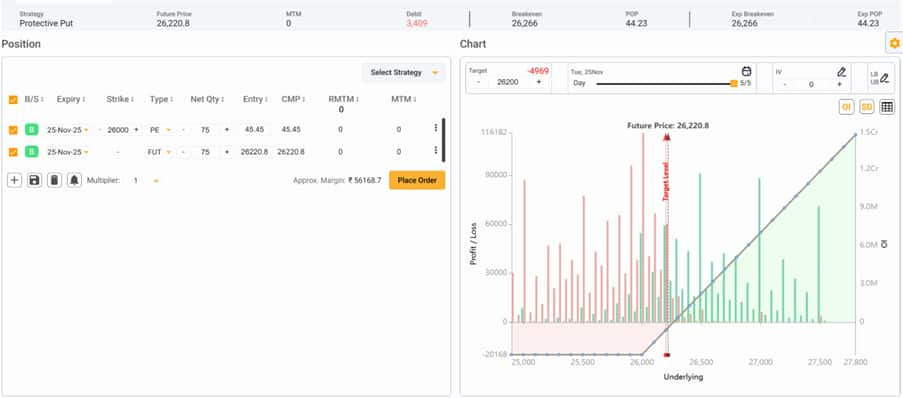Hold to hold investments peacefully with the help of Options
Events in equity markets are like death and taxes a certainty that comes every once in a while, and brings with itself bouts of volatility.
SHUBHAM AGARWAL | 11-May-19
Reading Time: 3 minutes

undefinedEvents in equity markets are like death, and taxes a certainty that comes every once in a while, and brings with itself bouts of volatility . We have talked about how traders optimize the equity options to modify their risk profiles and amplify their returns, but today, let us revisit Option’s utility for investors, who could be interested in modifying price profile of their invested stocks at least for a while (till the event is over)
We will focus on how a set of intentions of an investor can be monetised using equity options. But before we go any further let us revisit the four option transactions, what would they essentially mean:
A. Buying a put would entail a choice to sell a stockB. Buying a call would entail a choice to buy a stockC. Selling a put would entail obligation to buy a stock
D. Selling a call would entail obligation to sell a stock
Two additional Notables: Firstly, all aforementioned transactions would happen at a predefined price point for the stock a.k.a strike price. Secondly, the cost, while buying options would be the onetime cost of premium , selling options would require margin (a portion of entire transaction value) to be deposited up front but with a small receipt of premium.
Out of the four transactions at least two transactions can come in really handy while an event is in sight which is capable of bringing in volatility
1. With the event led volatility in expectation there would definitely come a fear of losing wealth in stock if the outcome of the event were to be worse, let us understand how Options can help investors take care of their fear. Well, use transaction A and buy a put of a strike below which one would not be comfortable holding the stock. In case the stock falls below the strike after the event, upon expiry we have a choice to sell the stock at strike price.
2. Again post the event there could be volatility pushing prices to mouth-watering levels but there is always a risk of losing while trying to catch a falling knife. While being the investor to the core and Buying the stock amid the most pessimism, resort to transaction A.
Buy a call instead, now one gets the choice to buy the stock on the day of expiry. Exercise the choice if the stock ends up above the strike price upon expiry. But in case if the stock were to fall further, just don’t buy it.
In terms of transaction cost, cost would be premium (3-5 percent of the stock price). Put option will protect the investor against any fall below the strike price at the end of expiry. The call option premium is paid to buy the comfort of getting in only if turns out to be a moneymaker.
3. Lastly, transactions C& D involve selling of options where comes a commitment but still if there is an intent to execute a buy at a price regardless of what the future holds for the stock resort to transaction C.
4. Similarly, in case one wishes to sell a stock at a predefined price and wouldn’t want anything more than what the stock has to offer resort to transaction D and sell a call of the strike price at which one wishes to sell the stock.
But transactions C&D would require margin but, which could partially be covered with the stockholding or earmarked capital for a further buy. While transactions A&B are protection mechanism to be better safe than sorry.
Learn and read more about volatility meaning from Quantsapp classroom which has been curated for understanding of stock trading from scratch, to enable option traders grasp the concepts practically and apply them in a data-driven trading approach.
Recent Articles

How to make profit when markets go sideways: Shubham Agarwal
20-Dec-25

Beyond Panic: Take control when your derivatives trade turns red, says Shubham Agarwal!
13-Dec-25

Evolve Your Trade: The missing step in most trading systems: Shubham Agarwal
06-Dec-25

Best trending option trading strategies: Shubham Agarwal
29-Nov-25

3 best ways to hedge using Options: Shubham Agarwal!
22-Nov-25

When in doubt to write, do Iron Fly: Shubham Agarwal!
15-Nov-25

Identify potential turning points with advance-decline: Shubham Agarwal
08-Nov-25

Slow and spreads more efficient: Shubham Agarwal
01-Nov-25

SHUBHAM AGARWAL is a CEO & Head of Research at Quantsapp Pvt. Ltd. He has been into many major kinds of market research and has been a programmer himself in Tens of programming languages. Earlier to the current position, Shubham has served for Motilal Oswal as Head of Quantitative, Technical & Derivatives Research and as a Technical Analyst at JM Financial.
Recent Articles

How to make profit when markets go sideways: Shubham Agarwal
20-Dec-25 12:14:00

Beyond Panic: Take control when your derivatives trade turns red, says Shubham Agarwal!
13-Dec-25 09:12:00

Evolve Your Trade: The missing step in most trading systems: Shubham Agarwal
06-Dec-25 20:43:00

Best trending option trading strategies: Shubham Agarwal
29-Nov-25 09:32:00

3 best ways to hedge using Options: Shubham Agarwal!
22-Nov-25 09:11:00

When in doubt to write, do Iron Fly: Shubham Agarwal!
15-Nov-25 10:48:00

Identify potential turning points with advance-decline: Shubham Agarwal
08-Nov-25 10:35:00











